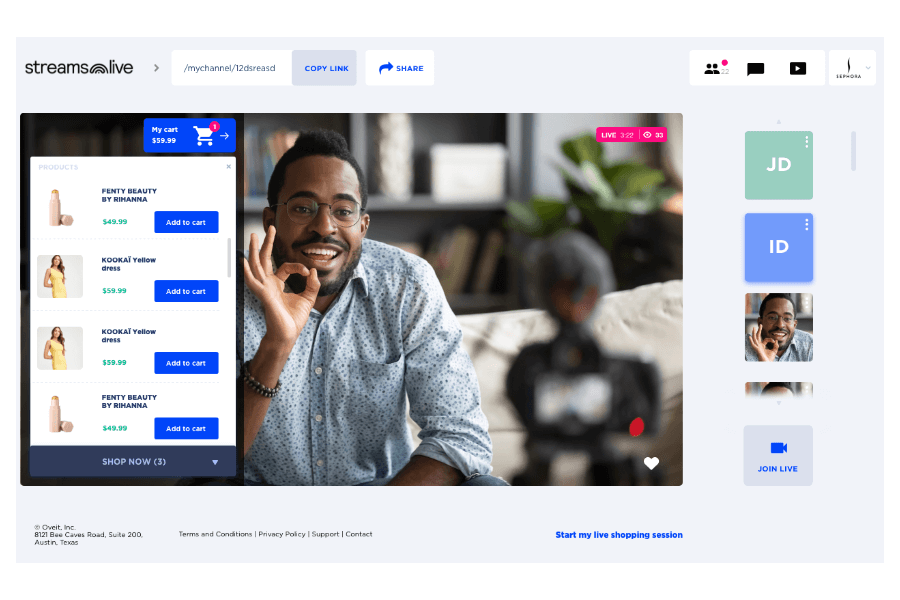
Have you heard about live shopping, the new way of buying? You probably have, but even if you didn’t, don’t worry. By the end of this article, you will have a better understanding of what live shopping is, how it works, and why it became so popular over the last few years. But most importantly, why this trend will continue to rise over the next years.
But first thing first!
What is Live Shopping?
Live shopping (or live commerce) is the shopping experience where customers buy from a live video experience that focuses on product showcasing. On one side, we have an influencer or a shopping assistant that presents products and engages the audience. On the other side of the screen, you have your potential customers that are watching the live presentation, ask questions, engage with other viewers, and at the right moment purchase the desired products straight from the live experience. As you can see, the scope is to showcase products and answer product-related questions. And at the right moment, customers can purchase the products with a single click of a button, straight from the live video experience.
Unlike traditional eCommerce, live shopping mixes entertainment and shopping through live video. But it’s not just about the fun: by engaging the viewers, you encourage them to ask relevant product-related questions. The ones that may stop them from buying. From this point of view, live shopping bridges the gap between online and offline, taking the best from both. From the comfort of their homes, customers can still interact live with a shop assistant, receiving the best recommendations that suit their needs.
The history behind Live Shopping
The trend started in China, the leading eCommerce market, and saw rapid growth over the last few years. If the total GMV (merchandise value) generated by B2C live shopping in 2017 was $3 billion, the estimations are that in 2021 the total GMV will reach $300 billion. Quite the growth!
In Europe, 7 out of 10 customers are looking to participate in live buying events and buy straight from the live video, regardless of the device they are using to watch the show: smartphones, laptops, tablets, or smart TVs.
In the US, the industry will steadily increase to $25 billion by 2023, as social commerce becomes the norm for the younger generations like Millennials and Gen Zs. As we are looking forward to the biggest wealth generational transfer in history – Millennials will hold over $68 trillion by 2030, their way of shopping is becoming the norm.

Worldwide, it’s estimated that the TMA (total achievable market) of live shopping will reach 1 Trillion by the end of 2024, making it the fastest-growing commerce trend in history.
As more and more businesses enter the eCommerce market, customers have started looking for new, more engaging experiences. The static experience is not enough anymore. As we have entered the era of ‘Experience Economy”, shoppers value the experience as much as products themselves. While goods become commodities, experiences become priceless. And live video shopping is here to help you create better shopping experiences for your audience.
How efficient live shopping events are?
Compared to classic eCommerce, Live Shopping Sessions have, on average, a 5X better conversion rate. Simply put, the average conversion rate for these shows is at 9%!
So shopping live is fun, but it’s this the only reason that makes it so efficient? Of course not! What makes it so efficient is the fact that this way of shopping naturally covers some of the most important aspects of any efficient eCommerce product page.
And here are the most important 5 elements of high-converting landing pages:
1. Visuals; high-quality images and videos
2. Customer testimonials
3. Your FAQ section
4. A clear, visible call to action
5. Content that’s relevant and sounds human
For a better understanding of why these sections are important to any eCommerce platform and how a live shopping event will take care of them, we recommend you to read our article that focuses on the conversion rates of live commerce vs classic e-commerce.
This interactive experience enables two-way communication, and it allows you to use different formats to deliver a shopping experience that encourages your audience to take action. The focus of any live shopping session is, of course, on selling. Bit the live video experience also allows viewers to get a better understanding of your vision, goals, and values. It will allow them to connect at a deeper level, leveraging your authenticity. In the long term, allowing people to truly know you and your team will help you build a community around your business. This new way of buying is the gift that keeps on giving.
Live Shopping events format

When it comes to the format, there are multiple ways you can create live shopping events. We’ll mention here the most important ones, but we have an article entirely dedicated to live shopping events format.
Product Presentations
Showcasing multiple products will help you cross-sell products as you can show how your different products can work together.
Behind the scenes
Invite your customers to take a look at what happens behind closed doors. This will help your audience get a better understanding of who you are and what you stand for. Most importantly, will bring the authenticity they are looking for.
Q&A sessions
Encourage people to ask questions and use this information to deliver better products and experiences. Almost 9 out of 10 online shoppers have at least one question they need to find an answer to before making a purchase.
Product launches
Invite your loyal customers to be the first to see your new collections. Encourage people to register to stay up to date with your releases.
Influencer collaboration
Invite top influencers to (co)host your shopping sessions. This will help you get access to new audiences, expanding your reach.
After deciding on the format, you will of course need to think about the actual set-up of the experience. Going live in front of a camera may sound overwhelming, but it’s not. If you are not planning on working with a professional filming team yet still want to create that look and feel, we’ve put together for you a checklist that focuses on lights and cameras. If you are searching for that authentic experience, you can go live straight from our mobile app. A ring light is all you may need – but even that is entirely up to you.
Final words
We hope this short walk-through helped you get a better understanding of what live shopping is and why it become so popular amongst brands and online shoppers. This new, interactive online experience is here as social commerce becomes a part of our day-to-day activities. Nowadays, the online shopping journey starts wherever your customers first interact with your brand and needs to be delivered as a two-way communication experience. And live shopping does exactly that.





